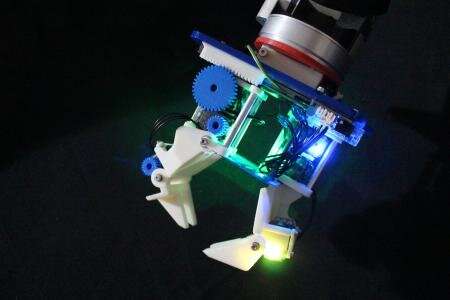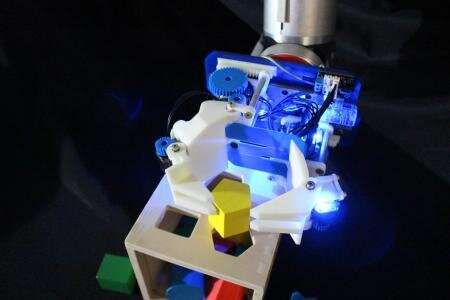A simpler, but dexterous robot hand

Humans use all surfaces of the hand for contact-rich manipulation. Robot hands, in contrast, typically use only the fingertips, which can limit dexterity. In a new study from the lab of Aaron Dollar, professor of mechanical engineering & materials science & computer science, researchers took a non-traditional approach to creating a new design for robotic hands.
The research team—graduate students Walter Bircher and Andrew Morgan, and Dollar—designed a two-fingered dexterous hand. Known as "Model W," it was inspired by the high levels of dexterity seen in humans' hand movements and robotic caging grasps—a strategy used to loosely trap objects between the fingers of a hand, preventing object ejection while allowing some free motion to occur. With the goal of making the design a useful tool for others in the robotic manipulation community, the researchers made the design a relatively simple one, with inexpensive components. They have also released the design through Yale OpenHand (an open-source robot hand hardware initiative).
Here, lead author Bircher explains the work and its significance:
Tell us about the background of the project, and how you got involved in this field.
People have been designing dexterous robotic hands for nearly 50 years, but have not achieved the same level of dexterity seen in human hands. This is in part because human hands regularly make and break contacts with an object and utilize all surfaces of the hand, skills that are difficult for robotic hands to emulate. Even decades ago, the advantages of using rolling and sliding contacts between the fingers and the object for increased dexterity were noted, while prominent manipulation models only took fixed contacts into account. In this work, we describe a model that allows for rolling, sliding, and fixed contacts, enabling the design of highly dexterous robotic hands.
I became interested in robotic hand manipulation during college, after doing an internship in the robotic manipulation group at the NASA Jet Propulsion Laboratory. I followed this interest to Yale to pursue a Ph.D. in the Dollar group. Our group is generally interested in optimizing the utility of underactuated and mechanically simple robotic hands. Using this mentality, I became interested in studying how design can improve the manipulation capabilities of simple hands, especially while leveraging non-persistent contacts (rolling and sliding) between the hand and the object.
What's the significance of this work?
In general, robotic hands have limited ability to roll or slide an object without dropping it, which constrains their utility in a dynamic, human environment. This work provides a new way to extend the dexterity of simple hands, without requiring the complicated math of traditional models, which could enable robotic hands to be used in household environments, the workplace, and other situations where dextrous, human-like manipulation is needed. Our hand, the Model W, presents an example of the kind of freeform manipulation that would be useful in a changing, everyday environment and presents a step towards robotic interaction with tools, objects, and even people.
Who might disagree with this?
Some researchers model manipulation in a way that keeps track of all contact forces, friction, object locations, etc. while manipulating which enables the stability of the grasp to be calculated, avoiding object ejection. However, this approach can be challenging because object contact locations and force magnitudes and directions are difficult to measure accurately, and friction coefficients can change over time. In our approach, we only consider caging and the overall energy of the system. Some might consider this method "messier" because it provides less precise information about the nature of hand-object contacts. However, by leveraging freeform contacts and ensuring object caging, we achieve high dexterity and low risk of object ejection which makes this an advantageous method.

What's the most exciting part of these findings?
In the past, we've used energy maps with existing robotic hands to assess their capabilities and control their manipulation of objects, but have never used energy maps to design a totally new hand. So after lots of theoretical modeling and engineering to build the Model W, it was so exciting to see it manipulate objects for the first time and confirm that it could perform as well as the theory predicted. It was especially exciting that the Model W showed a very high success rate when performing a wide range of tasks, indicating that the caging strategy reliably prevented object ejection and produced a depedenably dexterous hand.

What are the next steps with this, for you or other researchers?
The Model W was designed for planar (2D) manipulation but many tasks require spatial (3D) manipulation. So, one goal of our future work is to extend this model to three dimensions and produce a more general-purpose dexterous hand. We are also working to extend the energy map model to create a closed-loop controller for real-time control, which will require optimizing the computational efficiency of the model. We hope that using energy maps will improve on the basic control strategies shown in this work by more precisely directing the motors in a hand to achieve the desired motions of an object. Also, we hope that other research groups will utilize our theory in their own work and also use the Model W as a platform for testing manipulation strategies.
More information:
techxplore.com/news/2021-05-hi … aging-mechanism.html
Provided by Yale School of Engineering and Applied Science